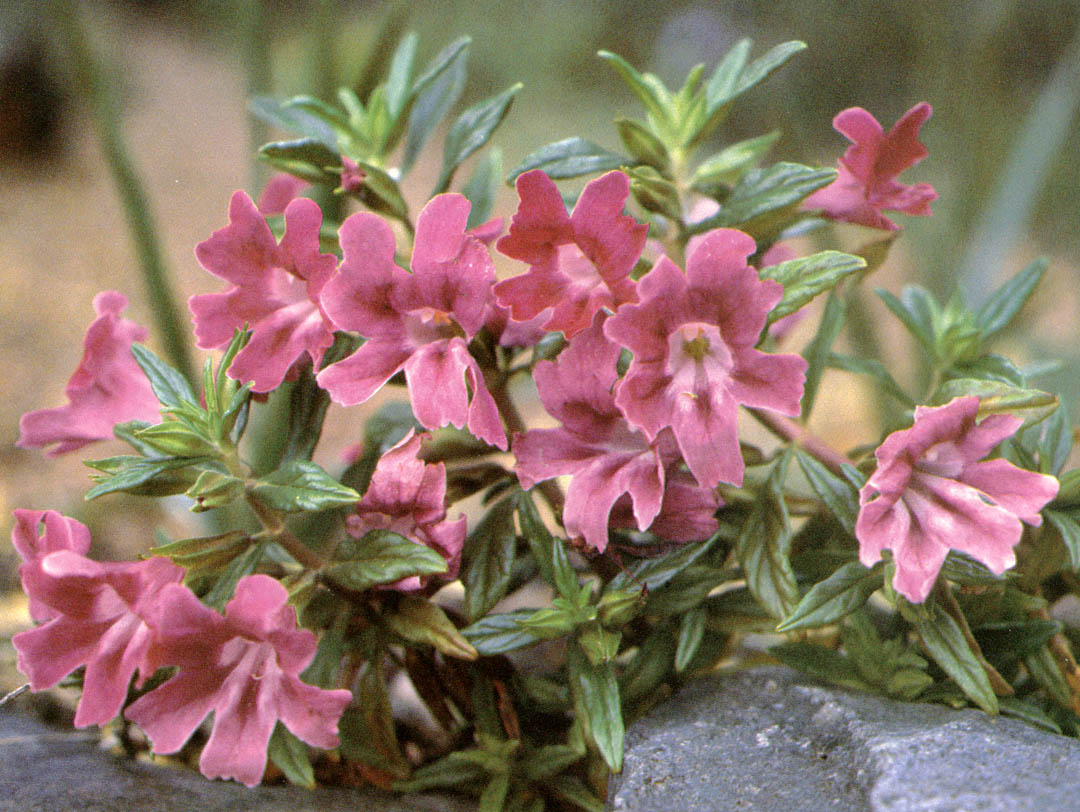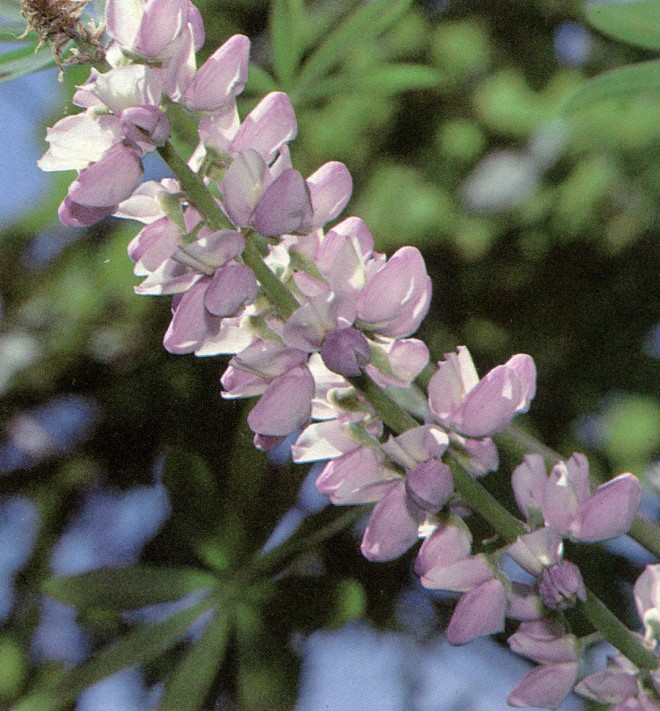
Three Chaparral Borders

Contributor

[Chaparral] is the most conspicuous plant community in the state. Its closest equivalents elsewhere… are the Mediterranean coast maquis, the Australian “bush” and the New Zealand “scrub.”
From scrub oak, or chaparro, comes the term chaparral. It is because chaparral contains so much formidable chaparro that those who penetrate it on horseback encase their legs in chaparreros or chaparajos or just plain “chaps. “
Lester Rowntree, Flowering Shrubs of California
Steep banks, light soil, and a western exposure are not ideal conditions for a perennial border, but they are what I have to work with as horticulturist at Earthside Nature Center in Pasadena, California. Fortunately, the native flora of California includes many plants that will accept such conditions, even with little or no summer watering. These l include in my chaparral borders: one in a very hot location with no summer water, one in a slightly cooler situation with some summer water, and another designed to attract hummingbirds.
The hottest and driest of my borders edges a large hillside devoted to ceanothus, fremontias, and manzanitas. The tall Penstemon spectabilis and the familiar low-growing P. heterophyllus, both in shades of blue and violet, are star spring performers. They are joined late in the season by prickly phlox (Leptodactylon californicum), which is short-lived but adds a cascade of shimmering pink flowers.
Golden yarrow (Eriophyllum confertiflorum), while somewhat rank at low elevations, is brilliantly colorful and prolific. The flowers of this plant, as much as those of Yucca whipplei, proclaim June to the traveler in southern California, from the sea cliffs to the yellow pine forest to the sun-scorched hillsides of the desert’s edge. Although it is impossible to predict at what age yuccas will flower, they are used here in quantity for their excellent foliage. Yucca whipplei is one of the state’s most characteristic plants and should be used much more in cultivation.

From among the yuccas in the background emerge the stout stalks of scarlet larkspur (Delphinium cardinale). Adaptable to sun or shade, its glowing red flowers can light up the dry shade of an oak grove or provide a blaze of color on a hot sunny bank. A special favorite in this border is a marvelously compact and floriferous form of sulfur buckwheat (Eriogonum umbellatum). This plant bears countless clusters of intensely yellow flowers held slightly above the gray spoon-shaped leaves and seems utterly immune to heat, drought, and air pollution.
The success of species of Indian paint-brush in these chaparral borders came as a surprise. I never expected to be able to grow these members of the figwort family, which are described in the botanical literature as partial root parasites, deriving some of their sustenance from other plants by attaching their roots to those of the host. Still, the sparkling turquoise seeds of Castilleja foliolosa, peering out from their handsome woody pods, encouraged me to give them a try. I have since used other species as well, and have had at least some flowers from every one attempted, so they can be considered a possibility for cultivation. I sow the seeds around other perennials and shrubs, and, although the rate of germination is poor, the plants flower the first year. C. foliolosa has grown well in conjunction with white sage, but the most successful has been the showy C. affinis sown on a hillside with its common companion of the coastal sage scrub, Salvia Ieucophylla.
A bank with some mid-day shade from a sycamore but full afternoon sun provides a home for a dry border of plants from the coast and Channel Islands. The emphasis here is on foliage, mostly in shades of silver-blue and gray-green. Shaw’s century plant, dudleyas, dune tansy, and beach sagebrush do splendidly with a minimum of irrigation.

Two favorite foliage plants in this group are introductions of the Santa Barbara Botanic Garden. Artemisia californica ‘Canyon Gray’ is a prostrate sagebrush whose soft gray-green foliage does for our banks what Iuniperus horizontalis ‘Wiltonii’ does in traditional gardens, but with a much finer texture. Salvia ‘Dara’s Choice’ has good blue flowers and makes an excellent knee-high groundcover, its branches thickly clothed with dark green leaves. A somewhat similar plant and one that will take more heat and drought is Salvia mellifera ‘Point Mugu’.
For flowers this border depends on blue-eyed grass, wild hollyhock, and above all, the diplacus hybrids of Dave Verity at the University of California, Los Angeles. These large-flowered bush monkeyflowers present a tremendous range of colors and flower over a period of several months. They enjoy a somewhat cooler situation, as do the popular iris hybrids descended from Iris douglasiana, I. munzii, I. innominata, and I. bracteata, A favorite among these is the justly famous Iris ‘Canyon Snow’, also from the Santa Barbara Botanic Garden. We have planted ‘Canyon Snow’ with another lovely white cultivar called ‘Chimes’ from local iris breeder Vern McCaskill; it is one of the earliest native irises to flower. These two produce a succession of flowers from late February to early June.

My third example of a chaparral border includes native plants from several plant communities brought together solely for the delight of hummingbirds. Especially valuable are two desert shrubs, bladderpod and chuparosa, which bloom abundantly in winter when nectar is scarce. In comparison, the menu for spring and early summer amounts to a smorgasbord of scarlet bugler and other penstemons, crimson sage, woolly blue-curls, Indian pink, manzanita, tree mallow, and monardella. For late summer and fall there are large patches of Epilobium canum subsp. angustifolium (Zauschneria californica), the aptly named hummingbird’s trumpet or California fuchsia.
If the three chaparral borders described here cannot compete with the grace and charm of an English country manor’s border, they do demonstrate that even a very hot dry site can provide ornament in the form of flowers, foliage, and hummingbirds poised in mid-air.
Share:
Social Media
Garden Futurist Podcast
Most Popular
Videos
Topics
Related Posts

Ground Up Science for Greener Cities with Garden Futurist Dr. Alessandro Ossola
Spring 2023 Listen to the Podcast here. Alessandro Ossola is a scientist who gets very excited about the challenge of climate change allowing for an

Readying Urban Forests for Climate Realities with Garden Futurist Dr. Greg McPherson
Winter 2023 Listen to the Podcast here. “Going from the mow and blow to a more horticulturally knowledgeable approach to maintaining the landscape. And that

Welcome, Greywater, to the Garden
Summer 2022 Oh, summer: delightful warm air, tomatoes swelling on the vine, fragrant blooms on an evening stroll. When it’s warm and rainless, how is

Big Tree-Data and Big-Tree Data with Garden Futurist Matt Ritter
Summer 2022 Listen to the full Garden Futurist: Episode XV podcast here. We are in an environmental crisis right now in many parts of California










Responses